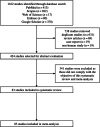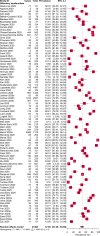Prevalence of Olfactory Dysfunction in Coronavirus Disease 2019 (COVID-19): A Meta-analysis of 27,492 Patients
- PMID: 33219539
- PMCID: PMC7753439
- DOI: 10.1002/lary.29286
Prevalence of Olfactory Dysfunction in Coronavirus Disease 2019 (COVID-19): A Meta-analysis of 27,492 Patients
Abstract
Objectives/hypothesis: Olfactory dysfunction has been observed as one of the clinical manifestations in COVID-19 patients. We aimed to conduct a systematic review and meta-analysis to estimate the overall pooled prevalence of olfactory dysfunction in COVID-19 patients.
Study design: Systematic review and meta-analyses.
Methods: PubMed, Scopus, Web of Science, Embase, and Google Scholar databases were searched to identify studies published between 1 December 2019 and 23 July 2020. We used random-effects model to estimate the pooled prevalence with 95% confidence intervals (CIs). Heterogeneity was assessed using the I2 statistic and Cochran's Q test. Robustness of the pooled estimates was checked by different subgroup and sensitivity analyses This study is registered with PROSPERO (CRD42020183768).
Results: We identified 1162 studies, of which 83 studies (n = 27492, 61.4% female) were included in the meta-analysis. Overall, the pooled prevalence of olfactory dysfunction in COVID-19 patients was 47.85% [95% CI: 41.20-54.50]. We observed olfactory dysfunction in 54.40% European, 51.11% North American, 31.39% Asian, and 10.71% Australian COVID-19 patients. Anosmia, hyposmia, and dysosmia were observed in 35.39%, 36.15%, and 2.53% of the patients, respectively. There were discrepancies in the results of studies with objective (higher prevalence) versus subjective (lower prevalence) evaluations. The discrepancy might be due to false-negative reporting observed in self-reported health measures.
Conclusions: The prevalence of olfactory dysfunction in COVID-19 patients was found to be 47.85% based on high-quality evidence. Due to the subjective measures of most studies pooled in the analysis, further studies with objective measures are advocated to confirm the finding.
Level of evidence: 2 Laryngoscope, 131:865-878, 2021.
Keywords: COVID-19; Coronavirus; meta-analysis; olfactory; smell.
© 2020 American Laryngological, Rhinological and Otological Society Inc, "The Triological Society" and American Laryngological Association (ALA).
Figures



References
-
- WHO . Coronavirus disease 2019 (COVID‐19) Weekly Epidemiological Update. October 23, 2020. Available at: https://www.who.int/emergencies/diseases/novel-coronavirus-2019/situatio.... Accessed October 26, 2020.
-
- Menni C, Valdes A, Freydin MB, et al. Loss of smell and taste in combination with other symptoms is a strong predictor of COVID‐19 infection. medRxiv 2020. 10.1101/2020.04.05.20048421. - DOI
Publication types
MeSH terms
LinkOut - more resources
Full Text Sources
Medical
Research Materials

